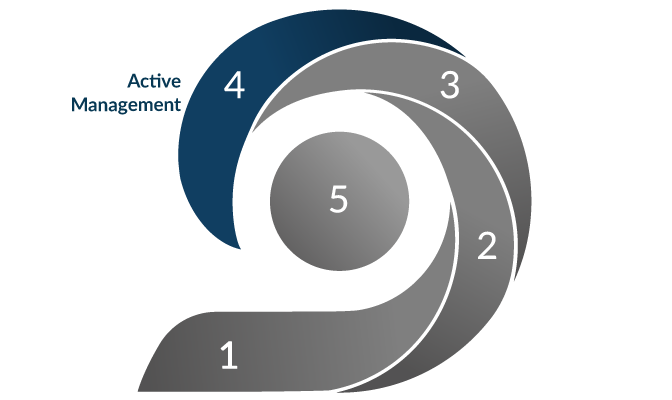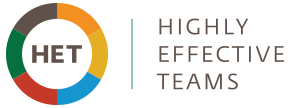
HET® for Strategy Teams
Module 4: Active Management
The fourth stage of high performance teamwork is Active Management, a two-step process of first, ensuring you deliver on the work you promised, and second, that it achieves the intended impact.

The wave graphic illustrates how the modules fit together over the life cycle of a team. Module 4 focuses on Active Management.
Key Principles
Module 4 consists of three key principles:

Keep Your Momentum Going
Create a clear team cadence so that team members know what to expect to happen when in the year and you prioritize time for managing and improving team performance.
Adopt a Rhythm is about codifying the lifecycle of a strategy or departmental team around a recurring cadence, so that
- Everyone knows what to expect to happen throughout the year (and we do not keep getting surprised by the need to attend to seasonal requirements), and
- We build in breaks from the day-to-day work to step back and attend to the foundational needs of the team: strategic planning, budgeting, professional development, performance management, team building, and other needs.
The Team Calendar outlines the lifecycle of a team around a recurring schedule, like the steady beat of a drum, to keep us all on time and in rhythm.

Watch Where We’re Going
Create and collect measures to assess the impact of your work and to decide whether to maintain or revise your team’s strategy or direction.
Bring Measures is the state of teamwork when we check the soundness of our HET Strategy Theory of Change by bringing measures with which to assess how our progress. First, we ensure that we are meeting our commitments by getting the promised work done. Then, we examine leading indicators—called Key Intermediate Results—for our desired outcomes. Finally, we evaluate impact measures—called Outcomes—to see if our strategy is contributing to our desired change in the world or if we need to revise our HET Strategy Theory of Change. Each Outcome and Key Intermediate Result should have:
- A metric, which defines the method by which we will assess progress,
- A baseline measure, which defines the starting point against which we will assess progress using the selected metric, and
- A measures plan defining how we will collect and analyze the measure, how frequently, and at what cost.

Set Goals for Future Success
Create specific, measurable, and cascading goals for your strategy and each team member based on your evaluation of progress to date.
Commit to Goals is the teamwork stage in which we commit to new near-term goals and possibly revise our long-term goals, based on the measures we have analyzed to assess the strength of our strategy. Using the HET Goal Tracker tool, we confirm our going-forward ten year vision, three year picture, one year objectives, and quarterly goals per team or per person on a team. The goals cascade down from the big picture HET Strategy Theory of Change and are observable and measurable. These goals inform our next prioritization of our body of work.

The HET Framework
Module 1: Structure, Roles & Decisions
Module 2: Strategy Articulation & Prioritization
Module 3: Project Planning & Implementation
Module 4: Active Management
Module 5: HET for All
